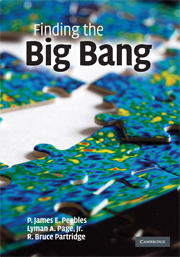1 - Introduction
Published online by Cambridge University Press: 05 July 2015
Summary
This is an account of the discovery and exploration of a sea of thermal radiation that smoothly fills space. The properties of this radiation (which we describe beginning on page 16) show that it is a fossil, a remnant from a time when our universe was denser and hotter and vastly simpler, a very nearly uniform sea of matter and radiation. The discovery of the radiation left from this early time is memorable because, as is often true of fossils, measurements of its properties give insights into the past. The study of this fossil radiation has proved to be exceedingly informative for cosmology, the study of how our universe expanded, cooled, and evolved to its present complicated condition.
The discovery of the fossil radiation grew out of a mix of lines of evidence that were sometimes misinterpreted or overlooked, and of ideas that were in some cases perceptive but ignored and in other cases misleading but entrenched. In the 1960s, it was at last generally recognized that the pieces might fit together and teach us something about the large-scale nature of the universe. We introduce the accounts of how this happened by explaining the lines of research that led up to the situation then. The story of what happened when the pieces were put together in the 1960s is told through the recollections of the people in the best position to know – those involved in the research. We have essays by most who took part in the recognition that this fossil exists, its properties may be measured, and what is measured may inform us about the nature of the physical universe. This did not happen all at once; nor was it done by a single person; nor was it always done knowingly. The collection of essays tell what happened in all the richness and complexity we suppose is typical of any activity that people take seriously.
- Type
- Chapter
- Information
- Finding the Big Bang , pp. 1 - 8Publisher: Cambridge University PressPrint publication year: 2009



